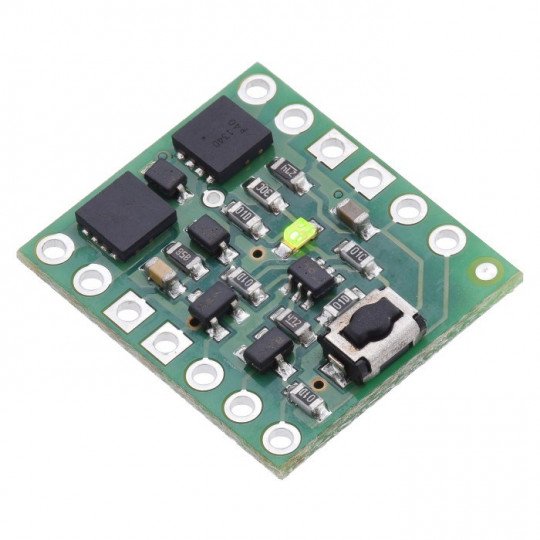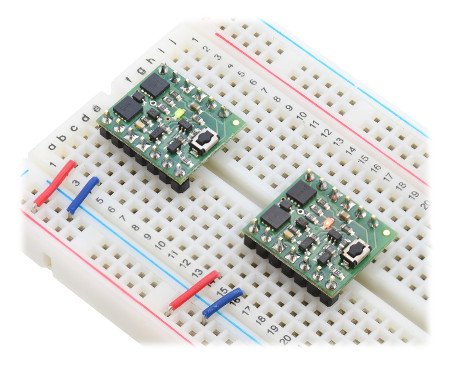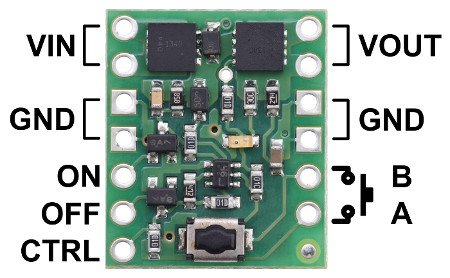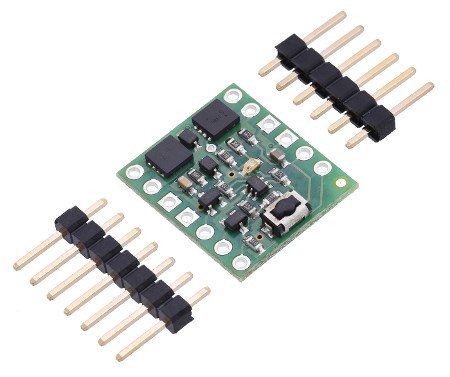Product description: Mini Push Switch MOSFET SV 4,5-40V / 4A - with reverse current protection - Pololu 2809
Push button module as an alternative to mechanical push buttons. The switch is bistable, one press turns the power on and another press turns it off. Additional inputs enable e.g. automatic switching off. The module operates from 4.5 V to 40 V with a current consumption of up to 4 A. The board has a built-in small pushbutton and allows the connection of external buttons. The switch current does not affect the circuit to be controlled, so you can use different pushbuttons to control a significant amount of power.
Advantages and limitations
The switch controls a pair of MOSFET transistors through which the main current flows. The module has many advantages but also disadvantages over mechanical switches. So, before using it in a circuit, you should be thoroughly familiar with its capabilities.
Advantages of
- Small size
- Protection against reverse current
- Possibility to connect several switches for better control
- Better characteristics than mechanical switches
- Possibility of self-decommissioning
- Possibility of digital control by external devices
- Compatible pin-outs, 2.54 mm pitch
Disadvantages
- Switch is unidirectional (VOUT voltage cannot be switched to VIN)
- Limited voltage range
- Switch may lose its state on power loss (defaults to off when power is first supplied, but may default to on near the upper operating range).
- Operates only with direct current
- No full isolation in the off state
Use of a switch
In basic use, the built-in push button is sufficient. One press turns the power on, another press turns it off. More advanced options are controlled by the other pins:
| Pin | Description |
|---|---|
| VIN | Supply voltage. |
| VOUT | Output voltage. |
| GND | System ground. |
| A |
Connection through momentary pushbutton with B pin for normal ON/OFF operation. Connection via momentary pushbutton to GND for continuous operation. |
| B | Connection via momentary push button to pin A for normal ON/OFF operation. |
| ON | A pulse above 1 V amplitude on this pin turns on the switch. |
| OFF | A pulse above with an amplitude above 1 V on this pin turns the switch off. |
| CTRL | Direct control of the switch state. A high state (over 1 V) turns the switch on, a low state turns it off. Unconnected does not set the switch state. CTRL and OFF pins should not be set to high state at the same time. |
Pins are soldering fields, allowing soldering goldpin connectors (raster 2.54 mm). Thanks to them, it's possible to connect the chip to a contact board or master module (e.g. STM32Discovery or Arduino) using wires.
For this MOSFET, the power that heats up the board is proportional to the square of the current flow. At a typical current of 2 A, it reaches 55 °C and becomes noticeably warm, but safe. With proper heat dissipation, 4.3 A can be achieved. However, we recommend extreme caution as the MOSFET transistor can heat up to 150 °C.
Push MOSFET switch specifications
- Maximum voltage: 40 V
- Recommended operating voltage: 4.5 to 32 V
- Continuous current at 55 °C: 2 A
- Continuous current at 150 °C: 4,3 A
- Maximum current: 7,2 A
- LED color: green
- Dimensions: 15 x 18 x 3 mm
- Weight: 0.6 g
Useful links |

































































































































































































































































































































































